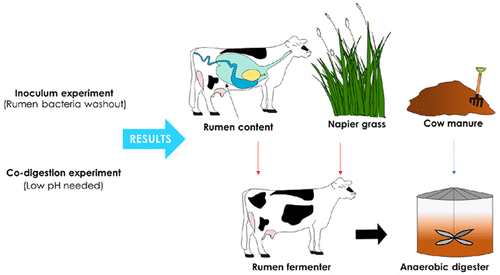当前位置:
X-MOL 学术
›
ACS ES&T Eng.
›
论文详情
Our official English website, www.x-mol.net, welcomes your feedback! (Note: you will need to create a separate account there.)
Understanding the Anaerobic Digestibility of Lignocellulosic Substrates Using Rumen Content as a Cosubstrate and an Inoculum
ACS ES&T Engineering Pub Date : 2021-01-31 , DOI: 10.1021/acsestengg.0c00164 Xavier Fonoll 1, 2 , Shilva Shrestha 1, 3 , Samir Kumar Khanal 3 , Joan Dosta 2 , Joan Mata-Alvarez 2 , Lutgarde Raskin 1
ACS ES&T Engineering Pub Date : 2021-01-31 , DOI: 10.1021/acsestengg.0c00164 Xavier Fonoll 1, 2 , Shilva Shrestha 1, 3 , Samir Kumar Khanal 3 , Joan Dosta 2 , Joan Mata-Alvarez 2 , Lutgarde Raskin 1
Affiliation

|
While rumen microorganisms are known to facilitate the hydrolysis of lignocellulosic substrates in anaerobic digestion (AD), it is unclear how rumen content can be used to maintain rumen microorganisms in continuous-flow AD systems. We used rumen content as either an inoculum or a cosubstrate in two separate AD experiments, and performed microbial and multivariate statistical analyses to study how to best use this resource to enhance AD. Hydrolytic bacteria such as Fibrobacter spp. remained present for two months of reactor operation when the rumen content was used as an inoculum, producing 0.3–0.5 g of short-chain fatty acids (SCFA) as acetic acid per gram of volatile solids (VS)fed. The lack of acetoclastic methanogens in the rumen content initially led to the accumulation of SCFA (10–15 g of SCFA as acetic acid per liter) as well as a low pH (5.9–6.8) and a low methane yield (0.02–0.05 L of CH4 per gram of VSfed). The reactor performed similarly (0.1–0.2 L of CH4 per gram of VSfed) to the control, which was not inoculated with rumen content, toward the end of the experiment, and the microbial analyses showed a washout of the rumen bacteria. Rumen hydrolytic bacteria remained in the reactor during the codigestion experiment. However, the methane yield (0.1–0.2 L CH4 per gram of VSfed) was similar to that of the control reactor, which did not receive the rumen content as a cosubstrate, because the reactor conditions (pH > 6.9) were not favorable for the activity of rumen bacteria. Our analyses suggest that using rumen content as a cosubstrate at a low pH (6.0–6.5) is necessary to maintain rumen hydrolytic bacteria and enhance hydrolysis.
中文翻译:

使用瘤胃含量作为共底物和接种物,了解木质纤维素底物的厌氧消化率
尽管已知瘤胃微生物可促进厌氧消化(AD)中木质纤维素底物的水解,但尚不清楚瘤胃含量如何用于在连续流AD系统中维持瘤胃微生物。我们在两个独立的AD实验中将瘤胃含量用作接种物或共底物,并进行了微生物和多元统计分析,以研究如何最佳利用此资源来增强AD。水解细菌,如Fibrobacter spp。当瘤胃含量用作接种物时,在反应器运行两个月后仍保持存在,每克进料的挥发性固体(VS)产生0.3-0.5 g短链脂肪酸(SCFA)作为乙酸。瘤胃中缺乏破乳产甲烷菌,最初导致了SCFA的积累(每升10-15克作为乙酸的SCFA),低pH值(5.9-6.8)和低甲烷生成量(0.02-0.05 L每克VS补料中的CH 4含量)。到实验结束时,反应器的性能与对照相似(0.1-0.2 L CH 4 / g VS进料的VS ),对照未接种瘤胃含量,而微生物分析显示,瘤胃细菌被洗净了。在共消化实验期间,瘤胃水解细菌保留在反应器中。但是,甲烷的产率(0.1-0.2 l的CH 4每克VS的馈)与对照反应器相似,后者没有将瘤胃含量作为共底物,因为反应器条件(pH> 6.9)不利于瘤胃细菌的活性。我们的分析表明,在低pH值(6.0-6.5)下使用瘤胃含量作为共底物对于保持瘤胃水解细菌和增强水解作用是必要的。
更新日期:2021-03-12
中文翻译:

使用瘤胃含量作为共底物和接种物,了解木质纤维素底物的厌氧消化率
尽管已知瘤胃微生物可促进厌氧消化(AD)中木质纤维素底物的水解,但尚不清楚瘤胃含量如何用于在连续流AD系统中维持瘤胃微生物。我们在两个独立的AD实验中将瘤胃含量用作接种物或共底物,并进行了微生物和多元统计分析,以研究如何最佳利用此资源来增强AD。水解细菌,如Fibrobacter spp。当瘤胃含量用作接种物时,在反应器运行两个月后仍保持存在,每克进料的挥发性固体(VS)产生0.3-0.5 g短链脂肪酸(SCFA)作为乙酸。瘤胃中缺乏破乳产甲烷菌,最初导致了SCFA的积累(每升10-15克作为乙酸的SCFA),低pH值(5.9-6.8)和低甲烷生成量(0.02-0.05 L每克VS补料中的CH 4含量)。到实验结束时,反应器的性能与对照相似(0.1-0.2 L CH 4 / g VS进料的VS ),对照未接种瘤胃含量,而微生物分析显示,瘤胃细菌被洗净了。在共消化实验期间,瘤胃水解细菌保留在反应器中。但是,甲烷的产率(0.1-0.2 l的CH 4每克VS的馈)与对照反应器相似,后者没有将瘤胃含量作为共底物,因为反应器条件(pH> 6.9)不利于瘤胃细菌的活性。我们的分析表明,在低pH值(6.0-6.5)下使用瘤胃含量作为共底物对于保持瘤胃水解细菌和增强水解作用是必要的。



























 京公网安备 11010802027423号
京公网安备 11010802027423号